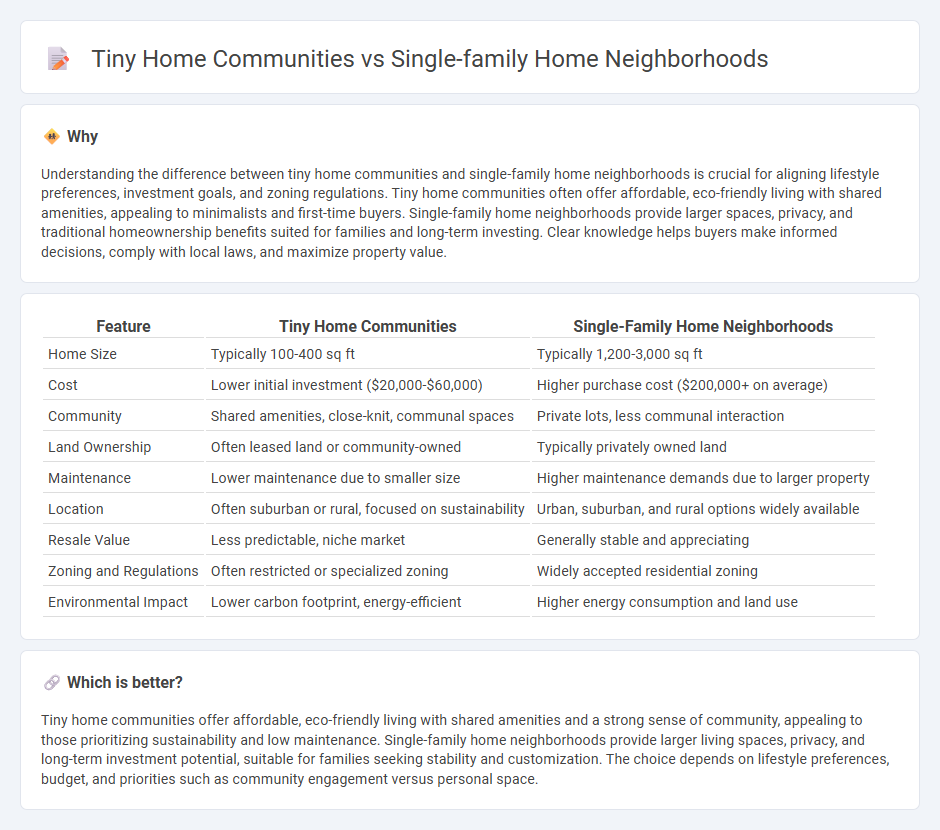
Tiny home communities offer affordable, space-efficient living with a strong focus on sustainability and community engagement, contrasting with the larger lot sizes and privacy typically found in single-family home neighborhoods. These compact neighborhoods appeal to environmentally conscious buyers seeking lower utility costs and simpler lifestyles, while single-family homes provide more room for families and long-term investment potential. Explore the benefits of each housing option to find the best fit for your real estate goals.
Why it is important
Understanding the difference between tiny home communities and single-family home neighborhoods is crucial for aligning lifestyle preferences, investment goals, and zoning regulations. Tiny home communities often offer affordable, eco-friendly living with shared amenities, appealing to minimalists and first-time buyers. Single-family home neighborhoods provide larger spaces, privacy, and traditional homeownership benefits suited for families and long-term investing. Clear knowledge helps buyers make informed decisions, comply with local laws, and maximize property value.
Comparison Table
| Feature | Tiny Home Communities | Single-Family Home Neighborhoods |
|---|---|---|
| Home Size | Typically 100-400 sq ft | Typically 1,200-3,000 sq ft |
| Cost | Lower initial investment ($20,000-$60,000) | Higher purchase cost ($200,000+ on average) |
| Community | Shared amenities, close-knit, communal spaces | Private lots, less communal interaction |
| Land Ownership | Often leased land or community-owned | Typically privately owned land |
| Maintenance | Lower maintenance due to smaller size | Higher maintenance demands due to larger property |
| Location | Often suburban or rural, focused on sustainability | Urban, suburban, and rural options widely available |
| Resale Value | Less predictable, niche market | Generally stable and appreciating |
| Zoning and Regulations | Often restricted or specialized zoning | Widely accepted residential zoning |
| Environmental Impact | Lower carbon footprint, energy-efficient | Higher energy consumption and land use |
Which is better?
Tiny home communities offer affordable, eco-friendly living with shared amenities and a strong sense of community, appealing to those prioritizing sustainability and low maintenance. Single-family home neighborhoods provide larger living spaces, privacy, and long-term investment potential, suitable for families seeking stability and customization. The choice depends on lifestyle preferences, budget, and priorities such as community engagement versus personal space.
Connection
Tiny home communities and single-family home neighborhoods share a growing trend of promoting affordable, sustainable living options within residential areas. Both housing types contribute to diverse community planning by integrating compact, efficiently designed spaces that address urban density challenges. Their coexistence supports a balanced real estate market offering varied property sizes suited to different lifestyle needs and economic conditions.
Key Terms
Zoning regulations
Single-family home neighborhoods often face stringent zoning regulations that mandate minimum lot sizes, setbacks, and restrictions on accessory dwelling units, limiting housing density and diversity. Tiny home communities challenge these traditional zoning codes by advocating for flexible land use policies and allowances for smaller footprint dwellings that promote affordability and sustainable living. Explore detailed zoning frameworks and legal adaptations driving the growth of tiny home communities compared to conventional single-family neighborhoods.
Property value
Single-family home neighborhoods typically offer higher and more stable property values due to larger lot sizes, traditional zoning, and broader market demand. Tiny home communities often face challenges with property appreciation because of zoning restrictions, limited space, and niche market appeal. Explore the impact of these factors on your investment to make informed real estate choices.
Community amenities
Single-family home neighborhoods typically feature extensive community amenities such as parks, swimming pools, playgrounds, and clubhouses designed to cater to families and larger households. Tiny home communities often emphasize shared spaces like communal gardens, co-working areas, and multipurpose gathering spots, promoting social interaction and sustainable living. Explore how these differing amenities impact lifestyle choices and community engagement.
Source and External Links
Single-family zoning - Single-family home neighborhoods are often restricted by single-family zoning laws that allow only detached single-family homes, excluding townhomes or apartments, a practice common in many U.S. cities and increasingly under reform to address housing shortages and segregation.
Miami Single-Family Homes for Sale - Popular neighborhoods for single-family homes, such as Coral Gables and Coconut Grove in Miami, are known for good schools, parks, and upscale living combining comfort and style.
Single-family home definition and explanation - Single-family homes provide privacy, space, and freedom to modify the property, making them ideal for buyers seeking independence and a traditional homeownership experience.
 dowidth.com
dowidth.com